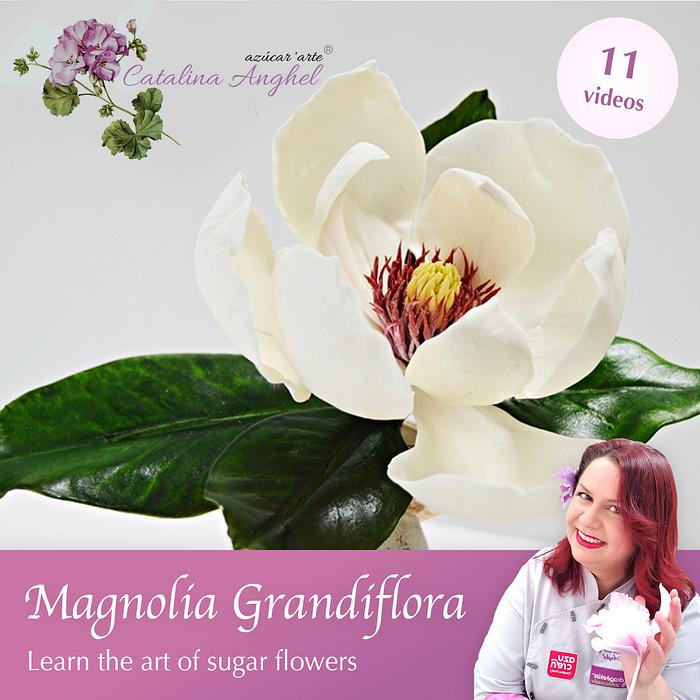Free-Formed Sugar Magnolia Grandiflora
Free-Formed Sugar Magnolia Grandiflora

Is there anyone that does not love this huge white and elegant flowers? Magnolia Grandiflora is a delicate fragranced flower that blooms all around here – in the public parks and streets in my town you can find the beautiful trees that grows this fabulous flowers..
Do you want to join me and learn how to model one of this beauties too? Join me and we’ll start a new adventure in sugar flower’s world together!
Let’s learn more about this fabulous flower.
Magnolia grandiflora, commonly known as the southern magnolia or bull bay, is a tree of the family Magnoliaceae native to the southeastern United States, from Virginia to central Florida, and west to East Texas. Reaching 27.5 m (90 ft) in height, it is a large, striking evergreen tree, with large dark green leaves up to 20 cm (7+3⁄4 in) long and 12 cm (4+3⁄4 in) wide, and large, white, fragrant flowers up to 30 cm (12 in) in diameter.
Although endemic to the evergreen lowland subtropical forests on the Gulf and south Atlantic coastal plain, Magnolia grandiflora is widely cultivated in warmer areas around the world. The timber is hard and heavy, and has been used commercially to make furniture, pallets, and veneer.
Magnolia grandiflora is a medium to large evergreen tree which may grow 120 ft (37 m) tall.6 It typically has a single stem (or trunk) and a pyramidal shape.The leaves are simple and broadly ovate, 12–20 cm (4+3⁄4–7+3⁄4 in) long and 6–12 cm (2+1⁄4–4+3⁄4 in) broad, with smooth margins. They are dark green, stiff and leathery, and often scurfy underneath with yellow-brown pubescence.
The large, showy, lemon citronella-scented flowers are white, up to 30 cm (11+3⁄4 in) across and fragrant, with six to 12 petals with a waxy texture, emerging from the tips of twigs on mature trees in late spring.
Flowering is followed by the rose-coloured fruit, ovoid polyfollicle, 7.5–10 cm (3–3+7⁄8 in) long, and 3–5 cm (1+1⁄4–2 in) wide.
11 Video Lessons
-
 modeling stamens and pistil
modeling stamens and pistilCut a wire 18 thick in half. Make a hook on one end of the wire. Dye a piece of paste rubber paste the size of a large apricot with green food coloring to obtain a very light color. Dye another...
-
 assemble the center
assemble the centerPaint the base of the pistil with some plum petal dust. With the help of green florist ribbon assemble the stamens little by little around the pistil, stretching the tape while using it to activate...
-
 modeling petals
modeling petalsColor a piece of gum paste the size of an apricot with white powdered food coloring. Make pasta balls for later modeling the petals. It will take 3 balls size of the index fingernail – for small...
-
 modeling the leaves
modeling the leavesUsing the gumpaste previously dyed with green make pasta balls of different sizes to model various sizes leaves. Cut florist wire thick 24 in 3 to prepare wires for every leaf. Model as many leaves...
-
 paint the stamens
paint the stamensOn a clean kitchen paper put some pink food coloring. Paint with this color the stamens, to emulate the polen
-
 assembling the petals
assembling the petalsWith green florist ribbon start assembling the petals around the center. You start by assembling the small petals, one by one. The medium petals are still mounted in a second round, filling the...
-
 painting front part of leaves
painting front part of leavesOn a kitchen paper put leaf green petal dust. The face of all leaves is painted (the part where the nerves are deep).
-
 painting back part of leaves
painting back part of leavesOn a kitchen paper is put food coloring in khaki green powder (military green). The back of all the leaves is painted with this color- insist on painting, you do not have to leave uncolored spaces.
-
 glazing the leaves
glazing the leavesCover the work surface with several layers of clean kitchen paper. Spray edible lacquer spray on leaf faces (only on the green part) from a distance of about 10 cm, carefully so as not to overspray...
-
 making "wood knots" under the flower
making "wood knots" under the flowerUsing brown florist ribbon is assembled a knot or two under the flower. To make a knot proceeds as follows: – the tape is fixed on the stem, just let’s leave the flower. – they go down covering the...
-
 final assembling
final assemblingWith brown florist ribbon the leaves are assembled on the stem. The assembly is started by the smallest size leaves and continues to be assembled according to the size- from small to large.
Meet Your Instructor

Catalina Anghel azúcar'arte
My name is Catalina and I love sugar flowers ;)
I am addicted to sugar flowers veiners and edible petal dusts...LOL
I am a professional baker and sugar florist based in Vila-real( Castellón) Spain.
I developed my own method of making sugar flowers- I work free formed, all my flowers are made without using special cutters or templates.
I teach free formed sugar flowers both in grupal workshops or one to one tuition. Also have my online academy: Academia Azúcar´arte.
At the same time I study medicine at UJI University in Castellón and take care of my son, my husbant my beaggle and my cat.
huge sweet hugs
Catalina
🤗❤️